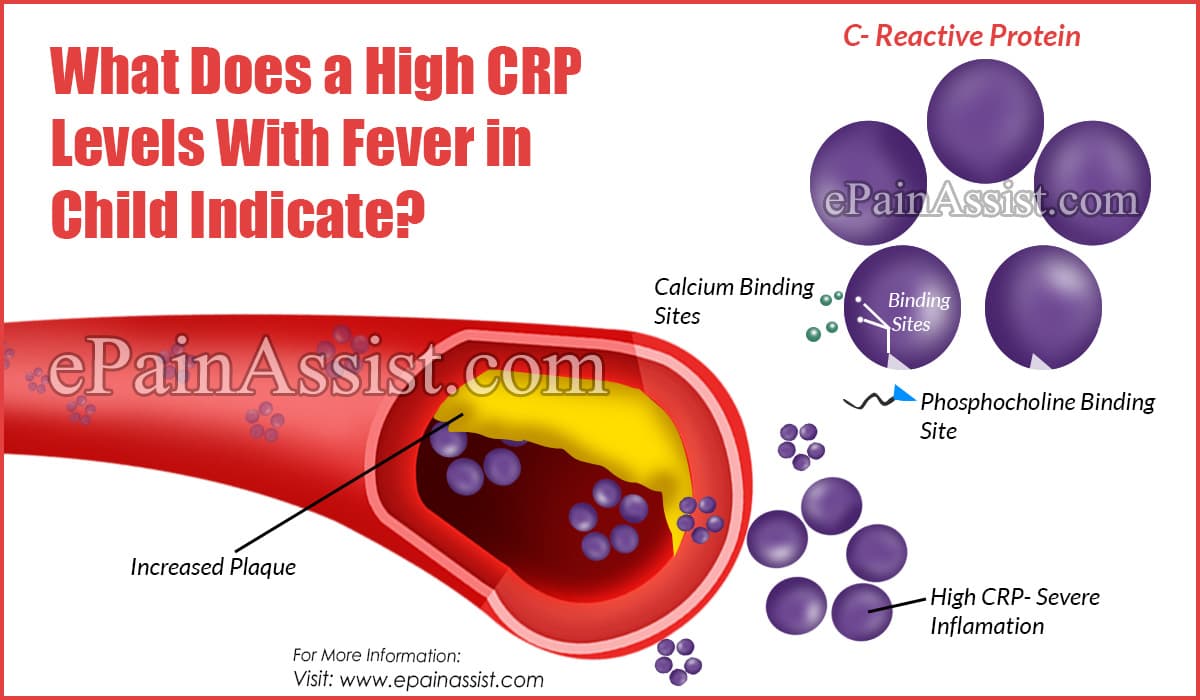The C-reactive protein or CRP is part of our immune system and when there is an inflammation or infection in the body, the CRP levels increases. There are conditions in children when there is a high CRP level along with fever. Read below to know what does a high CRP level with fever in child indicate.

What Does a High CRP Levels with Fever in Child Indicate?
High CRP levels with fever in the child may indicate the following conditions:
Sepsis: Sepsis is a condition where there is fever and chills, pain, headache, vomiting, nausea, confusion, shortness of breath along with skin rash. In this condition, there is a high CRP level in the blood of a child. So, if your child has a high CRP level along with fever, it might be possible that the child has sepsis.
Rheumatoid Arthritis: There is also an increase in the CRP level with low-grade fevers in case the child has rheumatoid arthritis. Your doctor may order the CRP test for the child if there are symptoms such as swelling of joints, pain, weight loss, tiredness, low-grade fever and morning stiffness in the child.
Dengue: Dengue fever can also mark a remarkable increase in the CRP level. Dengue is among the most significant arthropod-borne viral diseases in the world. Clinically dengue manifestation ranges from nonspecific febrile illness, dengue fever, and dengue hemorrhagic fever or DHF, to a more severe form of dengue shock syndrome or DSS. C-reactive protein levels are evaluated to distinguish between mild and severe cases of dengue in the early phases. CRP test can also help us discriminate between dengue and malaria. So, if your child has dengue, there is a high CRP with fever.
Pneumonia: Pneumonia is also a condition when there is a high CRP with fever in children. The diagnostic value of CRP level for pneumonia in children is unknown. C-reactive protein level has independent diagnostic value for pneumonia in children who are suspected to have pneumonia.
Osteomyelitis: Osteomyelitis is basically categorized as acute or chronic type, based on histopathologic findings, rather than the duration of the infection. Acute osteomyelitis is linked with inflammatory bone changes that are caused by pathogenic bacteria, and the symptoms usually occur within 2 weeks after the infection. In case of Chronic osteomyelitis, necrotic bone is present and the symptoms may not occur in the child until 6 weeks of the infection.
Increased CRP levels may be present in such a condition and there may also be fever in the affected child, especially in case of acute osteomyelitis.
Occult Bacteremia: A high CRP with fever in the child may also indicate a condition known as Occult bacteraemia. This is actually the presence of bacteria in the bloodstream of febrile young children who have no apparent foci of infection and who look absolutely well. The causes, evaluation and management of possible occult bacteraemia vary by the age of children and their immunization status. Occult bacteraemia is a concern as about 5% to 10% of the children with this condition, develop serious bacterial infections or SBIs, typically defined as, Sepsis, Meningitis and UTI, but also including Osteomyelitis and septic arthritis.
Children with serious bacterial infections and occult bacteraemia are more likely to have high C-reactive protein that children with benign infections.
Lupus: There may be possibility that your child might be suffering from lupus, if there is a high level of CRP along with fever and some other symptoms like skin rash, hair loss, swollen joints, kidney inflammation, gastrointestinal problems or pulmonary issues. There is an unexplained fever in this case. One of the early symptoms of lupus is a low-grade fever for no reason. Lupus is a systemic autoimmune disease that occurs when the immune system of the body attacks its own tissues and organs. The inflammation caused by Lupus can affect several body systems, including skin, joints, kidneys, brain, heart lungs and blood cells. The true symptoms of this disease can mimic many other illnesses, such as cancer and infection.
C-reactive protein levels tend to increase with this inflammatory process. The CRP levels increase very quickly, and may indicate lupus activity or may indicate a new infectious process somewhere in the child’s body
Enteric Fever or Typhoid: Enteric fever is caused due to intake of contaminated food or water by bacteria called as salmonella typhi. Symptoms of enteric fever or typhoid fever are often noted after a period of incubation (1 to 2 weeks) for about 3 – 4 weeks. Diagnosis often involves general examination followed by specific tests such as blood work, stool examination and urine analysis. An elevated CRP levels with fever in child can also be indicative of enteric fever.
Conclusion:
So, above we talked about some of the conditions that may show high CRP with fever in child. It is always essential for you to consult your pediatrician in case of any such symptom or in case of fever in child for no reason. Your child’s doctor would suggest you to go for the CRP test or any other test that might evaluate the exact underlying condition.
Also Read:
- Valley Fever or Coccidioidomycosis: Causes, Risk Factors, Symptoms, Diagnosis, Treatment, Prevention
- What is Mediterranean Spotted Fever or Boutonneuse Fever?
- What is Q Fever: Treatment, Recovery, Signs, Symptoms, Causes, Prevention, Epidemiology
- What is Viral Hemorrhagic Fever: Symptoms, Treatment, Carriers, Transmission, Facts, Prevention
- What is Lassa Fever, Know its Causes, Symptoms, Treatment, Prognosis, Diagnosis
- What is Traveler’s Fever, Know its Symptoms, Causes
- What is Yellow Fever, Know its Causes, Symptoms, Treatment, Prognosis
